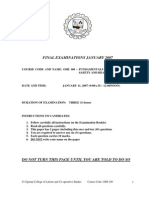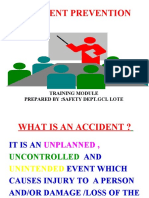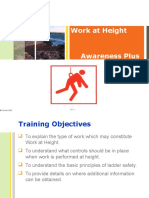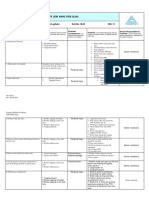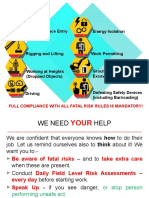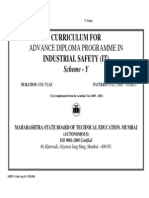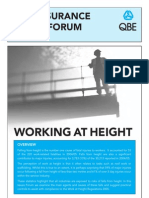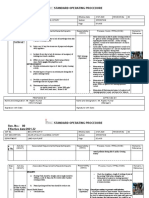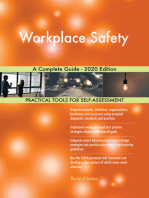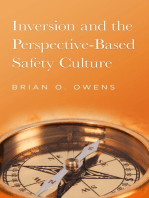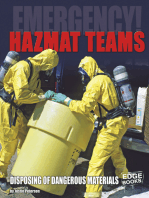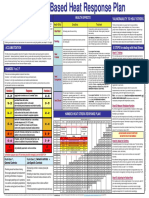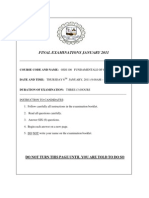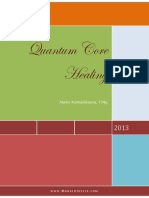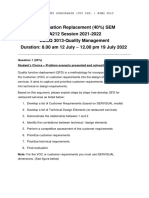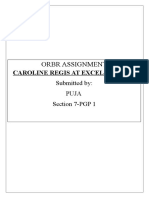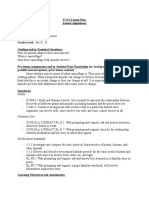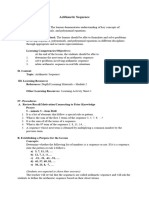Accident Prevention
Accident Prevention
Uploaded by
Devanand RamnarineCopyright:
Available Formats
Accident Prevention
Accident Prevention
Uploaded by
Devanand RamnarineOriginal Description:
Copyright
Available Formats
Share this document
Did you find this document useful?
Is this content inappropriate?
Copyright:
Available Formats
Accident Prevention
Accident Prevention
Uploaded by
Devanand RamnarineCopyright:
Available Formats
ACCIDENT PREVENTION
ACCIDENT PREVENTION OBJECTIVES 1. Legal objectives are given in local and/or national statute law, which details steps to be taken and carries the threat of prosecution or other enforcement action as a consequence of failure to comply. Civil law enables injured workers and others to gain compensation as a result of breach of statutory duties or because a reasonable standard of care was not provided under the circumstances. 2. Moral objectives derive from the concept that a duty or responsible care is owed to others. Greater awareness of the quality of life at and as affected by, work has focused popular attention on the ability of employers to handle a wide variety of issues, previously seen only as marginally relevant to the business enterprise. Environmental affairs, pollution, product safety and other matters are now commonly discussed, and there is a growing belief that it is simply morally unacceptable to put the safety and health of others inside or outside the workplace at risk, for profit or otherwise. Physical pain and hardship resulting from death and disability is impossible to quantify. Moral obligations are now more in the minds of employers than ever before. A dimension of the moral objective is morale, which also interlinks with the following two objectives. Worker morale is strengthened by active participation in accident prevention programmes, and weakened following accidents. Adverse publicity affects the fortunes of the organisation both internally in this way and externally, as public confidence may weaken local community ties, market position, market share and reputation generally. 3. Economic objectives are to ensure the continuing financial health of a business and avoid the costs associated with accidents. These include monetary loss to employers, community and society from worker injuries, damage to property and work interruptions. Some, but not all, of these costs are insurable in nearly all societies, and are known as direct costs. Increased premiums will be a consequence of claims, so an increase in overheads is predictable following accidents. Indirect costs include uninsured property damage, delays, overtime costs; management time spent on investigations, and decreased output from the replacement worker(s).
-1-
CAUSES OF INCIDENTS AND ACCIDENTS
The Sources of Incidents and Accidents A combination of factors or causes comes together under the right circumstances to bring about these undesired events. Seldom, if ever, is there a single cause of a downgrading incident involved with safety, production or quality. Available information has led managers to accept the following conclusions: 1. The incidents that downgrade our businesses are caused; they dont just happen. 2. The causes of downgrading incidents can be determined and controlled. Four major elements or sub-systems in the business operations individually or in combination provide the source of causes that contribute to a downgrading incident. In order to better understand the circumstances that give rise to the causes of undesired incidents, it would be helpful to consider these four major elements or subsystems in the total business operation that provide their sources. 1. People This element includes both employees and management. While it has been established that the human element is involved in a high percentage of incident causes, we must be ever mindful that what employees receive, or fail to receive by way of education, motivation and job tools, depends on their relationship with management people. The employee is usually the human element directly involved with most accidents, since what he does or fails to do is seen as the immediate causal factor. We must however remember the employee-management relationships that greatly influence these employee actions as we determine what the people related causes really are. 2. Equipment By equipment, we mean the tools and machinery that the employee works with. Machinery could involve such items as drill presses, lathes, cranes, lift trucks automobiles and tractors. 3. Material The material that people use, work with, or make provides another source of incident causes. Such material can be sharp, heavy, hot, or toxic. 4. Environment This is the physical surrounding, and may include buildings, the atmosphere that the people have to breathe, lighting level, noise level, and temperature.
-2-
Accident Ratio Study In 1969, a study done by the Insurance Company of North America revealed a relationship between Incidents and Accidents. This has come to be called the Accident Ratio Study, or, since it was conducted by Frank Bird, is also sometimes referred to as the Bird Theory.
Serious or Disabling Accidents
1
Minor Injuries Accidents
10
Property Damage Accidents Incidents, no Injury or Damage
(Near misses) The study also revealed that the occurrence of incidents, under slightly different circumstances could have resulted in property damage, or minor injury, or major injury. The 1-10-30-600 relationships in the ratio would seem to indicate quite clearly how foolish it is to direct our total effort at the relatively few events terminating in serious or disabling injury when there are 630 property damage or no loss incidents occurring that provide a much larger basis for more effective control of total accident losses. In addressing the many incidents that occur on a daily basis, and this is not difficult nor expensive to do, not only do we eliminate the potential for accidents that result in damage to property, injury, or even death, but we also eliminate many downgrading events that adversely affect the operation of the workplace.
30 600
-3-
Accident Causation In practice, accidents happen because a number of things have occurred simultaneously and it is the combination of these causal events which results in the accident. It follows from this that removing or changing any one of the causal events could prevent similar accidents in the future and, on a practical level, since some causal events are easier to influence than others, it is important for the investigator to identify all of the relevant causal events. These causal events are usually referred to as immediate or proximate causes and they are to do with what happened. In investigation terms, they can be identified by obtaining a detailed description of the accident and the events leading up to it. However, there is a second category of accident causes (usually referred to as the underlying or root causes) which deals with why the causal events happened. These causes are generally more difficult to identify in that it is easier, for example, to establish what occurred than it is to establish why it occurred. Nevertheless, it is only if these underlying causes are accurately identified that appropriate recommendations on remedial actions can be made and, for this reason, it is necessary to consider the Domino Theories which deal with the multiple underlying causes of accidents. Theories of accident causation: There are many accident causation theories, three of which will be considered in some detail later in this chapter, but before that some of the other theories will be considered:Pure Chance Theory: everyone in the population has an equal chance of an accident and there is no discernible pattern in events leading to an accident; accident is usually treated as an Act of God; i.e. prevention is not possible and is non existent. Biased Liability Theory: once a person has had an accident then the probability that they will have another is greatly reduced compared to the rest of the population at risk. Accident Proneness (Unequal liability) theory: certain sub group exists that is far more likely to incur accidents due to innate personality characteristics Theory of Unconscious Motivation: accidents are brought about by a subconscious process including guilt, anxiety, conflict, ambition. Reasons Swiss Cheese Model Under certain conditions, the holes in the slices line up, thus permitting the hazard to become an accident.
-4-
Each of these theories has advantages and disadvantages but few have been widely adopted in an occupational accident context. The more widely adopted accident causation theories have been the Domino sequence theories. HEINRICH'S DOMINO THEORY In 1959, the Late Herbert William Heinrich developed the original Domino Sequence Theory. Consider five dominoes standing on edge, and separated by spaces less than the height of each domino. If the first one topples, it strikes the second, which strikes the third, until domino number five falls over. This model can be used to illustrate that a chain or sequence of events can be listed in chronological order to show the events leading up to an accident.
This is how Heinrich's theory of accident causation works. According to Heinrich, there are five factors in the sequence of events leading up to an accident. These factors can be summarized as follows:
-5-
Domino No. 1 - Ancestry and social environment. Negative character traits that may lead people to behave in an unsafe manner can be inherited (ancestry) or acquired as a result of the social environment. Domino No. 2 - Fault of person. Negative character traits, whether inherited or acquired, are why people behave in an unsafe manner and why hazardous conditions exist. Domino No. 3 - Unsafe act mechanical or physical hazard. Unsafe acts committed by people and mechanical or physical hazards are the direct causes of accidents. Domino No 4 - Accident. Typically, accidents that result in injury are caused by falling or being hit by moving objects. Domino No. 5 - Injury. Typical injuries resulting from accidents include lacerations and fractures. Heinrich's theory has two central points:(1) Injuries are caused by the action of preceding factors; (2) Removal of the central factor (unsafe act/hazardous condition) negates the action of the preceding factors and, in so doing, prevents accidents and injuries. BIRD AND LOFTUS DOMINO THEORY In 1976, Bird and Loftus updated the domino theory to the form in use today. In the updated version: -
Domino No.1 - Lack of management control In the context of safety, Lack of Management Control could be failure to: Make inspections Conduct group meetings Indoctrinate new employees Make investigations of past incidents and accidents. Do job analyses Make job observations Review rules and procedures
-6-
Give proper job instructions. Plan work properly so as to avoid high work pressure. Install safety systems and barriers. Manage by two way communication Does not develop a health and safety culture within the organization. Assign and coordinate responsibilities. Financial restrictions Lack of commitment Lack of policy Lack of standards Lack of knowledge and information Restricted Training and selection of tasks.
Domino No. 2 - Basic causes. Basic causes are frequently classified into two groups: Personal factors o Low skill and competence levels. o Tired staff o Improper motivation, bored or disheartened staff. o Physical or mental problems. Job factors o Inadequate work standards o Illogical design of equipment and instruments. o Poorly maintained equipment o Missing or unclear instructions. o High workload. o Noisy and unpleasant working conditions. o Inadequate purchasing standard o Normal wear and tear o Abnormal usage. o Social Pressures. o Group attitudes o Trade customs o Tradition o Societal attitudes to risk-taking. o Acceptable behavior in the workplace.
Domino No. 3 - Immediate causes These are divided into Unsafe Acts and Unsafe Conditions. An unsafe act is a violation of any accepted safe procedure, which could permit the occurrence of an accident. Some examples are : 1. Operating without authority -7-
2. Failure to warn or secure 3. Operating at improper speed 4. Making safety devices inoperable 5. Using defective equipment 6. Using equipment improperly 7. Failure to use personal protective equipment. 8. Improper loading or placement 9. Taking improper position 10. Servicing equipment in motion 11. Horseplay 12. Drinking or drugs. An unsafe condition is a hazardous physical condition or circumstance, which could directly permit the occurrence of an accident. Some examples are:1. Inadequate guards or protection 2. Defective tools, equipment, substances. 3. Inadequate warning systems. 4. Congestion 5. Inadequate warning systems 6. Fire and explosion hazards 7. Substandard housekeeping 8. Hazardous atmospheric conditions: gasses, dusts, fumes, and vapours. 9. Excessive noise 10. Radiation exposure 11. Inadequate illumination or ventilation Domino No. 4 - Incident contact. Whenever substandard practices and conditions are permitted to exist, the door is always open for the occurrence of the incident that may or may not result in a loss. The incident is undesired since the final results of its occurrence are difficult to predict and are most frequently a matter of chance. As we said earlier, incidents that result in physical harm or property damage are referred to as accidents and usually involve a contact with a source of energy. The 1-10-30-600 ratio study also pointed out that more incidents occur that do not result in loss than do. It is important to recognize that each incident, whether or not it results in loss, provides an opportunity to obtain information that could prevent or control a similar future incident that could become an accident. Accidents are frequently classified according to their types. More common types are:1. Struck against 2. Struck by 3. Fall to below 4. Fall on same level 5. Caught in 6. Caught on 7. Caught between 8. Contact with a. electricity -8-
b. c d. e. f.
heat cold radiation caustics Overexertion (Over-load)
Domino No. 5 Loss Injury, Damage to Property, Damage to the environment.. Once the entire sequence has taken place and there is a loss involved with people or property, the results are usually chance events. The element of chance is involved in quality and production losses as well as those involved with safety, health and security. Losses involved with all areas of the business activity could be considered as minor, serious, major or catastrophic. PRIORITIES IN PREVENTION Basic principles should be observed in- setting up strategies for control and management of health and safety at work. These are: If possible, avoid a risk altogether by eliminating the hazard. Tackle risks at source avoid the quick temporary fix, or putting up a sign where a better physical control could be used (eg quieter machines rather than. provide personal protective equipment or erect warning signs) Adapt work to the individual when designing work areas and selecting methods of work Use technology to improve conditions Where options are available, give priority to protection for the whole workplace rather than to individuals (eg protect a roof edge rather than supply safety harnesses) Ensure that everyone understands what they have to do to be safe and healthy at work. Make sure that health and safety management is accepted by everyone, and that it applies to all aspects of an organisation's activities.
PRINCIPLES OF ACCIDENT PREVENTION In summary, these are: The systematic use of techniques to identify and remove hazards, The control of risks which remain, The use of. techniques to influence behaviour and encourage safe attitudes.
-9-
They are the primary responsibility of management.
- 10 -
You might also like
- Hira Workbook en - PdfuaDocument25 pagesHira Workbook en - PdfuaOgahNo ratings yet
- Tolley's Managing A Diverse WorkforceDocument235 pagesTolley's Managing A Diverse WorkforceDevanand RamnarineNo ratings yet
- 2007 OSH 100 Fundamentals of Occupational Safety and HealthDocument2 pages2007 OSH 100 Fundamentals of Occupational Safety and HealthDevanand RamnarineNo ratings yet
- 9 Unit 2 Accident TheoriesDocument61 pages9 Unit 2 Accident TheoriesSaru ArjunanNo ratings yet
- Accident Theories and Organisational FactorsDocument23 pagesAccident Theories and Organisational FactorsJorge Cronwell Montaño VásquezNo ratings yet
- Theory of Accident CausesDocument3 pagesTheory of Accident CausesvuongNo ratings yet
- Accident Prevention: Training Module Prepared By:Safety Dept - GCL LoteDocument30 pagesAccident Prevention: Training Module Prepared By:Safety Dept - GCL LotednkishoreNo ratings yet
- IGC1 Element 4 End of Element Questions and Answers Health and Safety Management Systems 3 - PlanningDocument5 pagesIGC1 Element 4 End of Element Questions and Answers Health and Safety Management Systems 3 - PlanningDrmusharraf AnsariNo ratings yet
- A Guide To Safe ScaffoldingDocument38 pagesA Guide To Safe ScaffoldingWinki CynthiaNo ratings yet
- Basic Work Accident Causation TheoryDocument105 pagesBasic Work Accident Causation TheoryJeremy NableNo ratings yet
- Lineward - BrochureDocument2 pagesLineward - BrochureLineward CorporationNo ratings yet
- Golden Peacock Occupational Health & Safety Award (GPOHSA)Document14 pagesGolden Peacock Occupational Health & Safety Award (GPOHSA)Keshav Singh RaoNo ratings yet
- Confined Space Entry - CCOHS-1Document12 pagesConfined Space Entry - CCOHS-1Mohamed hadjadj100% (1)
- Safety Award ApplicationDocument7 pagesSafety Award ApplicationJason Smith100% (1)
- Model Answer On VibrationDocument3 pagesModel Answer On VibrationhogoshNo ratings yet
- Work at Hight RegulationDocument12 pagesWork at Hight Regulationnight porterNo ratings yet
- Gpohsa-Guidelines-And-Application-Form - Safety-Converted - Filled inDocument42 pagesGpohsa-Guidelines-And-Application-Form - Safety-Converted - Filled inAryan AnandNo ratings yet
- AP Work Height SWPDocument30 pagesAP Work Height SWPfuazNo ratings yet
- Fy15 Sh-27664-Sh5 Toolbox Angle GrinderDocument2 pagesFy15 Sh-27664-Sh5 Toolbox Angle GrinderZakirhasNo ratings yet
- EBook - Contractor Safety ManagementDocument7 pagesEBook - Contractor Safety Managementmondi123No ratings yet
- Safety Notes (Updated 2022)Document13 pagesSafety Notes (Updated 2022)Awais AshrafNo ratings yet
- Accident Prevention Tool Box Talk Global EHS TBT 003Document6 pagesAccident Prevention Tool Box Talk Global EHS TBT 003Global EHSNo ratings yet
- M-45 Remove & Install Mud Tank AgitatorDocument3 pagesM-45 Remove & Install Mud Tank AgitatorMohamed AnwarNo ratings yet
- FATAL RISK ConstructioniDocument10 pagesFATAL RISK ConstructioniraghuvarmaNo ratings yet
- Eis 28Document4 pagesEis 28Ab AUNo ratings yet
- Industrial Safety CurriculumDocument67 pagesIndustrial Safety Curriculumrashid_siddiqi144100% (1)
- E-Book - Thermax - BBS Observer - 3 DaysDocument51 pagesE-Book - Thermax - BBS Observer - 3 Dayssampangi66100% (1)
- LOTO FinalDocument35 pagesLOTO FinalRizwan KaziNo ratings yet
- BBS EvaluationDocument2 pagesBBS EvaluationEmmanuelNo ratings yet
- Ans Sheet SHEL 23114Document139 pagesAns Sheet SHEL 23114Chetan PatilNo ratings yet
- Working at HeightDocument6 pagesWorking at HeightAykut KarakavakNo ratings yet
- SafetyDocument1 pageSafetysanjeev kumar0% (1)
- SOP 17 - Idler & Pulley Cleaning ActivityDocument6 pagesSOP 17 - Idler & Pulley Cleaning Activityfaraz ahmedNo ratings yet
- Standard For Old Age PDFDocument65 pagesStandard For Old Age PDFRendani VeleNo ratings yet
- 5a Hazard ManagementDocument45 pages5a Hazard ManagementChoa Pei ShuangNo ratings yet
- Occupational Safety and Health Risk Assessment of Workers in The Manufacturing IndustryDocument15 pagesOccupational Safety and Health Risk Assessment of Workers in The Manufacturing IndustryCj SesnorioNo ratings yet
- MSDS - MasterEmaco N 303 greyMSDS - MasterEmaco N 303 GreyDocument9 pagesMSDS - MasterEmaco N 303 greyMSDS - MasterEmaco N 303 Greyabo115116No ratings yet
- Fall Protection Quiz-2: (A) 3 FeetDocument3 pagesFall Protection Quiz-2: (A) 3 FeetHassan64041No ratings yet
- The Occupational Safety and Health (No.15 of 2007) PDFDocument244 pagesThe Occupational Safety and Health (No.15 of 2007) PDFWinstone AudiNo ratings yet
- Safety BookDocument18 pagesSafety BookSohag MiahNo ratings yet
- Practical PDIS 102Document147 pagesPractical PDIS 102UFC Fight ClubNo ratings yet
- ILO and IndiaDocument7 pagesILO and IndiaGlobal Justice AcademyNo ratings yet
- Safety Quiz - Answer PDFDocument1 pageSafety Quiz - Answer PDFRedzwan KadirNo ratings yet
- John Burke - Safe Work at HeightDocument32 pagesJohn Burke - Safe Work at HeightRoman DuranNo ratings yet
- Hse Plan 3Document14 pagesHse Plan 3YcRij SeYerNo ratings yet
- 22.04.2019 - Confined Space A Dangerous SpaceDocument1 page22.04.2019 - Confined Space A Dangerous SpaceVaibhav Vithoba NaikNo ratings yet
- Safety Hazard Identification On Construction ProjectsDocument19 pagesSafety Hazard Identification On Construction Projectshayatmdazhar100% (2)
- Reporting, Recording and InvestigationDocument28 pagesReporting, Recording and InvestigationAnnNo ratings yet
- Emergency Warden Training For ADDocument20 pagesEmergency Warden Training For ADsetiawanaji407No ratings yet
- Safety ManagementDocument17 pagesSafety ManagementMohaiminul IslamNo ratings yet
- JSO Slip, Trips & Fall (27 Aug.'07)Document1 pageJSO Slip, Trips & Fall (27 Aug.'07)Francis Enriquez TanNo ratings yet
- Scaffolding Awareness Rev 01 - 12 Mar 09Document22 pagesScaffolding Awareness Rev 01 - 12 Mar 09Raghavendra KiranNo ratings yet
- Accident Causation TheoriesDocument37 pagesAccident Causation TheoriesAizrul ShahNo ratings yet
- 1 Construction SafetyDocument26 pages1 Construction SafetyDenka100% (1)
- Stay Safe This Summer: Health and Safety for Young WorkersFrom EverandStay Safe This Summer: Health and Safety for Young WorkersNo ratings yet
- The Handbook of Safety Engineering: Principles and ApplicationsFrom EverandThe Handbook of Safety Engineering: Principles and ApplicationsRating: 4 out of 5 stars4/5 (1)
- Humidex Based Heat Response Plan FD - HumidexDocument1 pageHumidex Based Heat Response Plan FD - HumidexDevanand RamnarineNo ratings yet
- Examination Technique: Pace YourselfDocument3 pagesExamination Technique: Pace YourselfDevanand RamnarineNo ratings yet
- COM 101 Fundamentals of CommunictionDocument6 pagesCOM 101 Fundamentals of CommunictionDevanand RamnarineNo ratings yet
- ACC 210 Principles of AuditingDocument3 pagesACC 210 Principles of AuditingDevanand RamnarineNo ratings yet
- ACC 100 - Introduction To AccountingDocument10 pagesACC 100 - Introduction To AccountingDevanand RamnarineNo ratings yet
- 2011 2011 OSH100 - FUNDAMENTALS OF OSHOsh100 - Fundamentals of OshDocument2 pages2011 2011 OSH100 - FUNDAMENTALS OF OSHOsh100 - Fundamentals of OshDevanand RamnarineNo ratings yet
- Chapter 6 ReportDocument31 pagesChapter 6 ReportEloise Anne Tul-idNo ratings yet
- Academic Integrity and Dishonesty Paper FINAL-libreDocument26 pagesAcademic Integrity and Dishonesty Paper FINAL-librenisay_life2255No ratings yet
- Ielts VocabularyDocument35 pagesIelts VocabularyĐặng HoàNo ratings yet
- The Essential Guide To Workplace AccountabilityDocument11 pagesThe Essential Guide To Workplace AccountabilityUnni NarayananNo ratings yet
- Bird Beak Adaptation LabDocument5 pagesBird Beak Adaptation Labmichelle_phillips_jhs3020100% (1)
- A Critical Analysis On George Herbert Meads 'Self'Document7 pagesA Critical Analysis On George Herbert Meads 'Self'Shakil FarajiNo ratings yet
- Module 6 Safety and Security in The Learning EnvironmentDocument3 pagesModule 6 Safety and Security in The Learning EnvironmentkylieNo ratings yet
- From Tall Poppies To Squashed Weeds : Why Don't Nurses Pull Together More?Document8 pagesFrom Tall Poppies To Squashed Weeds : Why Don't Nurses Pull Together More?GabbiNo ratings yet
- Quantum CoreDocument30 pagesQuantum CoreestrellapistolaNo ratings yet
- L'OrealDocument21 pagesL'OrealPriya DattaNo ratings yet
- Final Soalan - QFDdan PDCA - 40Document9 pagesFinal Soalan - QFDdan PDCA - 40nr satiraNo ratings yet
- ORBR Case StudyDocument7 pagesORBR Case StudyPuaj100% (2)
- Camouflage Lesson PlanDocument4 pagesCamouflage Lesson Planapi-344569443No ratings yet
- Core HRMSDocument95 pagesCore HRMSdipakrpatrNo ratings yet
- How Do People Think? Mindsonar Making The, Visible: InvisibleDocument3 pagesHow Do People Think? Mindsonar Making The, Visible: InvisibleJennet BurghardNo ratings yet
- Marketing and Business ManagementDocument2 pagesMarketing and Business Managementleighann stoneNo ratings yet
- Ujian Masuk Program Pascasarjana: Jangan Dibuka Dulu. Tunggu PetunjukDocument21 pagesUjian Masuk Program Pascasarjana: Jangan Dibuka Dulu. Tunggu PetunjukLalu SuhaimiNo ratings yet
- His Surrogate Bride WatermarkDocument71 pagesHis Surrogate Bride Watermarknikitanitika4No ratings yet
- EDITED G9 Dressmaking TOS 1st Ptest 2023Document3 pagesEDITED G9 Dressmaking TOS 1st Ptest 2023Kimberly De torresNo ratings yet
- Aesthetic ComfortDocument4 pagesAesthetic Comfortsksadi12111998No ratings yet
- Population Sampling 4thDocument10 pagesPopulation Sampling 4thKhudadad Nabizada0% (1)
- Lecture 12 Revision SlidesDocument34 pagesLecture 12 Revision SlidesPio NguyenNo ratings yet
- University of Azad Jammu & Kashmir: Mir Aftab AliDocument18 pagesUniversity of Azad Jammu & Kashmir: Mir Aftab AliMir Aftab AliNo ratings yet
- Quality Given by David GarvinDocument12 pagesQuality Given by David Garvinanon_858236743No ratings yet
- Personality TypesDocument30 pagesPersonality TypesShaheer ArshadNo ratings yet
- Arithmetic Sequence Lesson PlanDocument3 pagesArithmetic Sequence Lesson Plankaiser arvinNo ratings yet
- The Power of ArtDocument1 pageThe Power of ArtRoberto Garcia Jr.No ratings yet
- Level 5 EmpolyabilityDocument7 pagesLevel 5 Empolyabilitygeorgebush oboteNo ratings yet
- Lesson Plan in Contemporary Arts: Grade 11-Einstein LavoisierDocument2 pagesLesson Plan in Contemporary Arts: Grade 11-Einstein LavoisierNida FranciscoNo ratings yet
- Storybook Lesson PlanDocument8 pagesStorybook Lesson Planapi-461599022No ratings yet



